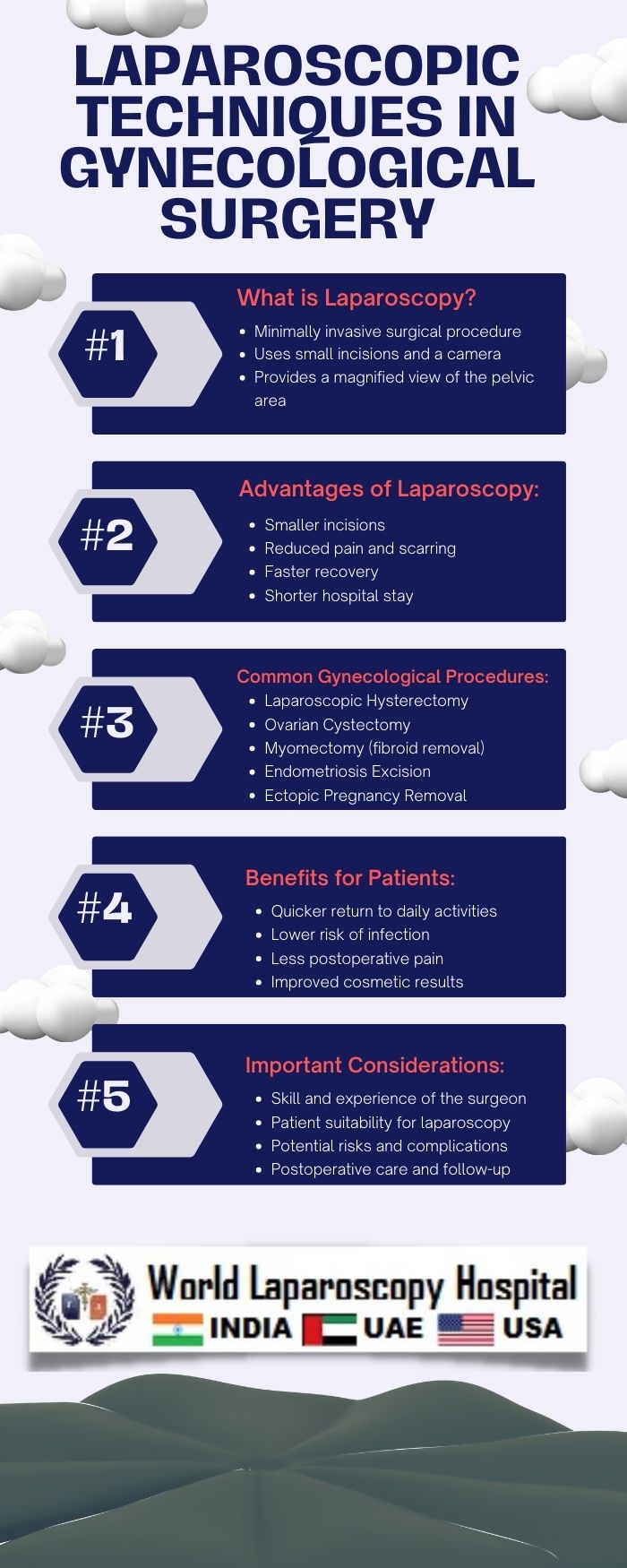Advancements in Laparoscopic Techniques in Gynecological Surgery
Introduction
Gynecological surgery has seen remarkable advancements in recent years, thanks to the adoption of laparoscopic techniques. Laparoscopy, also known as minimally invasive surgery, has revolutionized the field by offering numerous benefits over traditional open surgeries. In this article, we will explore the various laparoscopic techniques used in gynecological surgery and their advantages.

Laparoscopic gynecological surgery has its roots in the mid-20th century when the first laparoscopic procedures were performed. Initially, it was used primarily for diagnostic purposes. However, as technology improved and surgeons gained experience, the scope of laparoscopy expanded to encompass various therapeutic procedures in gynecology.
Laparoscopic HysterectomyOne of the most common gynecological surgeries performed using laparoscopic techniques is laparoscopic hysterectomy. This procedure involves the removal of the uterus through small incisions in the abdomen. The advantages of laparoscopic hysterectomy include shorter hospital stays, reduced pain, and faster recovery compared to traditional open hysterectomy.
Laparoscopic MyomectomyMyomectomy is a surgical procedure to remove uterine fibroids while preserving the uterus. Laparoscopic myomectomy offers a minimally invasive approach to treating fibroids, resulting in less scarring and a quicker return to normal activities for patients.
Laparoscopic Ovarian CystectomyOvarian cysts are a common gynecological condition that may require surgical intervention. Laparoscopic ovarian cystectomy allows for the removal of cysts with minimal disruption to surrounding tissues. It is associated with shorter hospital stays and a reduced risk of complications.
Laparoscopic Endometriosis SurgeryEndometriosis is a chronic condition in which tissue similar to the uterine lining grows outside the uterus. Laparoscopy is a valuable tool for both diagnosing and treating endometriosis. Surgeons can visualize and excise endometrial tissue with precision, providing relief to patients suffering from this painful condition.
Laparoscopic Tubal ReversalFor women who have previously undergone tubal ligation but wish to reverse the procedure, laparoscopic tubal reversal offers a minimally invasive option. This technique allows the reconnection of fallopian tubes, enabling the possibility of natural conception.
Laparoscopic SacrocolpopexyPelvic organ prolapse is a common issue among women, often necessitating surgical intervention. Laparoscopic sacrocolpopexy is a procedure that involves the placement of mesh to support the pelvic organs. It offers a minimally invasive alternative to traditional open surgery for addressing this condition.
Benefits of Laparoscopic TechniquesThe widespread adoption of laparoscopic techniques in gynecological surgery can be attributed to several significant benefits:
a. Reduced Scarring: Laparoscopic incisions are small, resulting in minimal scarring compared to large open incisions.
b. Faster Recovery: Patients often experience shorter hospital stays and quicker post-operative recovery times.
c. Less Pain: Laparoscopic surgery typically results in less post-operative pain, reducing the need for pain medication.
d. Improved Cosmetic Outcome: Smaller incisions lead to better cosmetic outcomes, which can be especially important for gynecological procedures.
e. Lower Risk of Infection: The risk of surgical site infections is reduced with laparoscopic techniques due to smaller incisions and decreased exposure to external contaminants.
Challenges and ConsiderationsWhile laparoscopic techniques offer numerous advantages, they are not without challenges. Surgeons must undergo specialized training to perform these procedures effectively. Additionally, some complex gynecological surgeries may still require traditional open approaches, depending on the patient's condition and the surgeon's expertise.
ConclusionLaparoscopic techniques have transformed the landscape of gynecological surgery, offering patients less invasive options with faster recovery times and improved outcomes. As technology continues to advance and surgeons gain more experience, the future of gynecological surgery looks promising. Patients can expect even more minimally invasive options and better overall care for their gynecological health.
In conclusion, laparoscopic techniques have revolutionized gynecological surgery by providing safer, less invasive, and more effective options for patients. The field continues to evolve, promising further advancements in the years to come, ultimately benefiting the health and well-being of women worldwide.